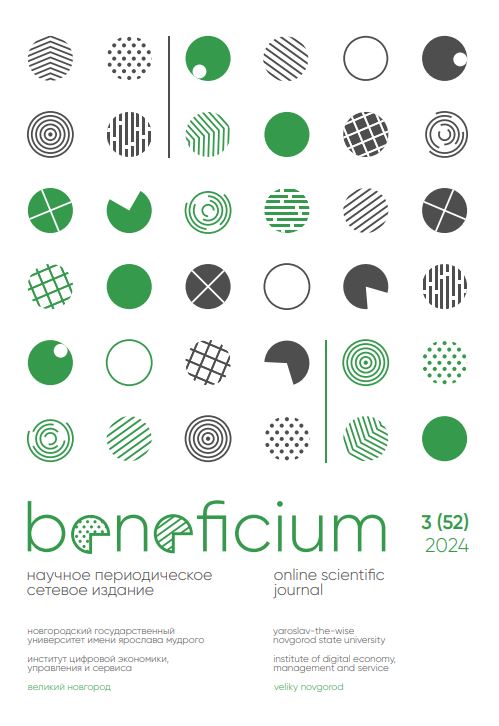STRUCTURAL AND FUNCTIONAL ANALYSIS OF THE FOOD SUPPLY SYSTEM
Abstract
The escalation of geopolitical instability is causing a sharp increase in attention to issues of resource provision of the state and its regions. In particular, regional food supply is pivotal in shaping food security, as it is at the regional level where the foundational elements for a successful food supply system are established. In practice, regional food supply is usually viewed as a systemic process, which was used in this study as a basic scientific approach. Drawing from the findings of summarizing information from various publications, the author determined that the regional food supply system is most often and reasonably presented in the literature as a set of four subsystems, each with its own developed structure. The completed decomposition of the goals and functions of these food supply subsystems as a systemic process made it possible to more deeply understand the process under study and determine a set of assessment indicators for the functioning of the food security system in the regions of Russia. As an example, the provisions of multiple areas within the Russian Federation were assessed using 24 indicators taken from the Russian Statistical Yearbook, the correlation between which was analyzed using the Spearman criterion. Building upon the regression analysis findings, it was deter-mined that a rise in per capita income does not always lead to an increase in food consumption. This is a result of alterations in consumption patterns and economic factors, including inflation and changes in food prices. Therefore, the obtained results can be used as a foundation for developing and implementing economic policies focused on the sustainable development of the food sector, as well as for refining the commonly accepted system of indicators.
Keywords: food supply, food supply indicators, food security, food supply system
References
⦁ Roubik H., Lostak M., Ketuama C.T., Soukupova J. COVID-19 crisis interlinkage with past pandemics and their effects on food security // Global Health. 2023. Vol. 19(1). Pp. 1-16. DOI: 10.1186/s12992-023-00952-7
⦁ Decree of the President of the Russian Federation of January 21, 2020 No. 20 “Ob utverzhdenii Doctrines prodovol'stvennoy bezopasnosti Rossiyskoy Federatsii” ["On Approval of the Doctrine of Food Security of the Russian Federation"] (2020). ConsultantPlus. (In Russ.). URL: https://www.consultant.ru/document/cons_doc_LAW_343386/ (accessed on 03.24.2024).
⦁ Regiony Rossii. Social'no-ekonomicheskie pokazateli [Regions of Russia. Socio-economic indicators] (2022). Federal State Statistics Service. (In Russ.). URL: https://rosstat.gov.ru/storage/mediabank/Region_Pokaz_2022.pdf (accessed on 04/23/2024).
⦁ Zegarra L.F. Living Costs and Welfare Ratios in Western Europe: new Estimates using a Linear Programming Model // European Review of Economic History. 2021. Vol. 26(1). Pp. 38-61. DOI: 10.1093/ereh/heab007
⦁ Kolesnyak A.A., Kolesnyak I.A. Situation and Trends in Food Consumption by the Population in the Region with Extreme Natural Conditions // IOP Conference Series Earth and Environmental Science. 2019. Vol. 315(7). Pp. 1-4. DOI: 10.1088/1755-1315/315/7/072008
⦁ Kolesnyak I.A. The Composition and Structure of Food Supply System // The Bulletin of KrasGAU. 2013. Vol. 5. Pp. 259-262. (In Russ.).
⦁ Baskakov S.M. Food Supply as an Economic Category: a Comparative Analysis of Russian and Foreign Scientific Views // ETAP: Economic Theory, Analysis, and Practice. 2020. Vol. 1. Pp. 77-96. (In Russ.). DOI: 10.24411/2071-6435-2020-10004
⦁ Amiri A., Mehrjerdi Y.Z., Jalalimanesh A., Sadegheih A. Food System Sustainability Investigation Using System Dynamics Approach // Journal of Cleaner Production. 2020. Vol. 277. DOI: 10.1016/j.jclepro.2020.124040
⦁ Kolesnyak A.A., Polozova T.V. The Structure and Evaluation Indicators of the System of Food Supply // The Bulletin of KrasGAU. 2009. Vol. 1. Pp. 12-18. (In Russ.).
⦁ Polyanskaya N.M., Kolesnyak A.A. Conceptual Approaches to the Regional Food Supply System Study // Socio-economic and humanitarian journal. 2023. Vol. 1. Pp. 14-23. (In Russ.). DOI: 10.36718/2500-1825-2023-1-14-23
⦁ Gumerov R.R. Desyat' let agrarnoj reformy: kuda prishli i chto delat'? [Ten years of agrarian reform: where have we come and what to do?] // Russian Economic Journal. 2000. Vol. 9. Pp. 35-51. (In Russ.).
⦁ Kolesnyak A.A., Polyanskaya N.M., Kolesnyak I.A. Food Security and Food Provision: Concept and Evaluation // Proceedings of the Southwest State University. Series: Economy. Sociology. Management. 2018. Vol. 8(3-28). Pp. 161-170. (In Russ.).
⦁ Sapunova M.A. Wholesale Distribution as a Component of the Food Security System // Research in Economic and Financial Problems. 2022. Vol. 4. Pp. 1-8. (In Russ.). DOI: 10.31279/2782-6414-2022-4-1-1-8
⦁ Zhiryayeva E.V. Food Security Indicators Classification and Assessment of Their Importance for the Policy of the Russian Federation // Administrative Consulting. 2020. Vol. 12(144). Pp. 49-67. (In Russ.). DOI: 10.22394/1726-1139-2020-12-49-67
⦁ Shardan S.K. The System of Indicators to Measure Food Security of the Population of the Region // Scientific news. 2015. Vol. 1. Pp. 49-54. (In Russ.).
⦁ Salikov Y.A., Magomaeva L.R., Sozaeva D.A., Molchan A.S., Ilʹina T.V. Cognitive Technologies in the Regional Economic Security Management // Business 4.0 as a Subject of the Digital Economy. 2022. Pp. 251-256. DOI: 10.1007/978-3-030-90324-4_41
⦁ Regiony Rossii. Social'no-ekonomicheskie pokazateli [Regions of Russia. Socio-economic indicators] (2017). Federal State Statistics Service. (In Russ.). URL: https://rosstat.gov.ru/storage/mediabank/peg-pok17.pdf (accessed on 04/23/2024).
⦁ Regiony Rossii. Social'no-ekonomicheskie pokazateli [Regions of Russia. Socio-economic indicators] (2018). Federal State Statistics Service. (In Russ.). URL: https://rosstat.gov.ru/storage/mediabank/Reg-pok18 (accessed on 04/23/2024).
⦁ Regiony Rossii. Social'no-ekonomicheskie pokazateli [Regions of Russia. Socio-economic indicators] (2019). Federal State Statistics Service. (In Russ.). URL: https://rosstat.gov.ru/storage/mediabank/Region_Pokaz_2019.pdf (accessed on 04/23/2024).
⦁ Regiony Rossii. Social'no-ekonomicheskie pokazateli [Regions of Russia. Socio-economic indicators] (2020). Federal State Statistics Service. (In Russ.). URL: https://rosstat.gov.ru/storage/mediabank/LkooETqG/Region_Pokaz_2020.pdf (accessed on 04/23/2024).
⦁ Regiony Rossii. Social'no-ekonomicheskie pokazateli [Regions of Russia. Socio-economic indicators] (2021). Federal State Statistics Service. (In Russ.). URL: https://rosstat.gov.ru/storage/mediabank/Region_Pokaz_2021.pdf (accessed on 04/23/2024).
About the Author
Xinyi Qian – Graduate Student, Voronezh State University of Engineering Technologies, Voronezh, Russia
E-mail: wzymcbymb2022@gmail.com. SPIN РИНЦ 5764-2546. ORCID 0009-0004-3227-2534
For citation: Qian X. Structural and Functional Analysis of the Food Supply System // Beneficium. 2024. Vol. 3(52). Pp. 85-95. (In Russ.). DOI: 10.34680/BENEFICIUM.2024.3(52).85-95









